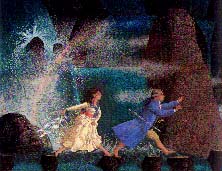|
________________
CM . . . .
Volume V Number 3 . . . . October 2, 1998
excerpt: Outside the temple walls, Pamina, who had been waiting for Tamino to reappear, had fallen asleep. When she awoke, shivering with cold, she found her mother towering above her, her dark cloak just visible against the black sky. Without even greeting her daughter, the Queen of the Night snapped, "Where is the prince I sent to rescue you?"  In this retelling of Mozart's famous opera, the young Prince Tamino, with the help of Papageno, the "birdman," attempts to rescue the Princess Pamina from her mother, the wicked Queen of the Night, and the Chancellor Monostatos. When Pamina and Tamino are
brought to the temple of the evil sorcerer, Sorastro, Tamino is told that he must face three trials before he can be considered worthy to have Pamina as his bride. The first trial is the vow of silence, the second is the wall of fire, and the third is t
he mountain of water. In each situation, Tamino, aided by his magic flute, passes the test with flying colours. Meanwhile, the Queen asks her daughter to kill Sorastro and steal the magic seal of the seven circles which her husband had given to Sorastro
. As it turns out, Sorastro is actually one of the "good guys" and announces that, through the courage and strength of Pamina's and Tamino's love, the kingdom will celebrate the dawning of peace. Monostatos and the Queen of the Night are hurled down into
the earth as the ground opens beneath them and swallows them up.
In this retelling of Mozart's famous opera, the young Prince Tamino, with the help of Papageno, the "birdman," attempts to rescue the Princess Pamina from her mother, the wicked Queen of the Night, and the Chancellor Monostatos. When Pamina and Tamino are
brought to the temple of the evil sorcerer, Sorastro, Tamino is told that he must face three trials before he can be considered worthy to have Pamina as his bride. The first trial is the vow of silence, the second is the wall of fire, and the third is t
he mountain of water. In each situation, Tamino, aided by his magic flute, passes the test with flying colours. Meanwhile, the Queen asks her daughter to kill Sorastro and steal the magic seal of the seven circles which her husband had given to Sorastro
. As it turns out, Sorastro is actually one of the "good guys" and announces that, through the courage and strength of Pamina's and Tamino's love, the kingdom will celebrate the dawning of peace. Monostatos and the Queen of the Night are hurled down into
the earth as the ground opens beneath them and swallows them up.
Though opera aficionados will enjoy this book, especially with the added bonus of an audio CD, readers who are unfamiliar with the opera will find the story confusing and convoluted [it's almost like listening to someone trying to describe yesterday's epi sode of a popular soap opera.] To add to the confusion, several characters appear and reappear briefly in the story [but without much explanation]; the names of the characters are very similar [Sorastro/Monostatos and Pamina/Tamino]; and, there is also a secondary love story between Papageno and Papagena which seems superfluous. The text, written in fairly simple language, is hurried and reads almost like a child's creative writing assignment, requiring two or three readings to get the gist. It is almost as if the author felt that she had to condense a three-hour opera into a sh ort book, yet was reluctant to leave out any details. Generally, the text appears on one page and a full-page illustration appears on the other. The illustrations, paintings rendered in rich tones of orange, gold, brown, teal and blue, depict the characters in the costumes of the late 1700's. Their lack of depth might be, to some, visually unappealing, but it is an attempt by the artist to convey a stage set rather than a real scene. Even the characters seem wooden, as if "frozen" in a tableau. Despite its shortcomings, the book has some redeeming qualities - the author has included a page about Mozart's life and a list of the musical selections which are paired with each illustration as well as a concise statement explaining the action. A small treble clef symbol appears at the bottom of each text page to indicate a particular selection number on the CD. Obviously written for the stage, this story loses some of its magic in print form. Not recommended. Gail Hamilton is a teacher-librarian at Bird's Hill School in East St. Paul, Manitoba.
To comment on this title or this review, send mail to cm@umanitoba.ca.
Copyright © the Manitoba Library Association.
Reproduction for personal use is permitted only if this copyright notice
is maintained. Any other reproduction is prohibited without
permission.
Published by
TABLE OF CONTENTS FOR THIS ISSUE - OCTOBER 2, 1998.
AUTHORS |
TITLES |
MEDIA REVIEWS |
PROFILES |
BACK ISSUES |
SEARCH |
CMARCHIVE |
HOME
|

